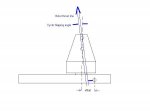I suppose, Udi, desirable rotor response Vs. offset/trim spring depends on the stability you begin with.
If a gyro is stable stick fixed, then you obviously don't need any more rotor response than blowback compenstaion, if that much.
Perhaps the best examples are both of Dick DeGraw's partially powered rotor gyros. Both use cyclic control methods that preclude rotor thrust feedback into the cyclic control system and both are normally flown with locked cyclic controls via a spring detent mechanism. The detent positions are trimable via handwheels.
When Dick and wife Karol fly these machines cross country, it's generally hands off once trimmed and on course.
On the other hand, to fly an unstable machine such as a stabless RAF-2000 hands off, you probably want all the help from rotor feedback you can get, much more than blowback compensation.


